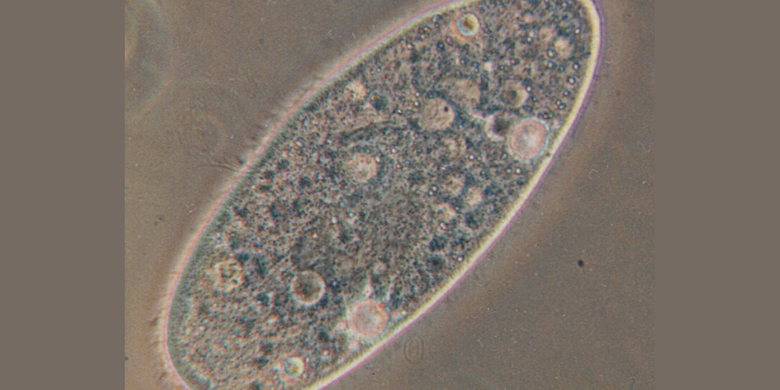By: Ani Rachman, Teacher at SDN No.111/IX Muhajirin, Muaro Jambi, Jambi Province
KOMPAS.com – Have you ever noticed organisms from a drop of water taken from a pond?
If observed using a microscope, there is an organism called Paramecium. The shape is elongated like the sole of the foot, about 0.06 millimeters wide, and about 0.3 millimeters long.
Paramecium has two kinds of cell nuclei. The large cell nucleus is useful for maintaining survival, while the small nucleus is useful for the reproduction process. Reproduction of Paramecium by self-cleavage or conjunction of two Paramecium.
Also read: Apatogenic Bacteria: Definition and Examples
Paramecium definition
Paramecium is one of the organisms belonging to the kingdom of animal-like protists or protozoa which is the easiest to find around pond waters or rice fields. Protozoa or animal-like protists come from the words proto (first) and zoa (animal).
In this world there are more than 40,000 species of protozoa living in various places such as waters, moist soil or some live as parasites. The shape of this organism is elongated like a sole of the foot, about 0.06 millimeters wide, and about 0.3 millimeters long.
Paramecium has two cell nuclei, namely the large incell and the small cell nucleus. The large cell nucleus is useful for maintaining survival, while the small cell nucleus is useful for reproduction. Reproduction of this organism takes place by self-cleavage or conjunction of two paramecium.
Part of the body there is a hole that serves as a mouth. Their diet consists of other microorganisms and organic matter. This food is crushed and processed in the organs that function as the intestines, then released to other parts of the body as food reserves.
Also read: Decomposing Bacteria: Definition and Examples
Characteristics of Paramecium
Paramecium has several characteristics, including:
At the end of the body it has a blunt part, then at the back it has a part which looks tapered. Has a shape of a cell wall Has a size of a body that is between 120-300 microns Has as many as two types of nuclei, namely the macronucleus and also the micronucleus Has as many as two types of contractile and non-contractile vacuoles Will be able to carry out movements to carry out processing of the cilia Do a vegetative and generative reproduction
commons.wikimedia.org/Deuterostome
The diagram is labeled Paramecium
Paramecium body parts
The body parts of Paramecium are as follows:
Cytoplasm is a cell fluid which is divided into two, namely ectoplasm and endoplasm.
The extoplasm is the outer layer which is turbid, dense, thin and tough. Also known as the cortical area, contains cilia, trichosis and pellicle.
Meanwhile, the endoplasm is the inner layer which is more fluid and thicker and contains lots of cytoplasmic granules. This structure contains a vacuole, nucleus, and mitochondria.
Also read: Viruses: Definition, Characteristics, Structure, Types, Differences with Bacteria
Divided into macronucleus and micronucleus.
Micronucleus is a large cell nucleus that contains nucleoli and DNA. Serves to control the activities of cell metabolism and asexual reproduction.
Micronucleus is a small cell nucleus that functions in sexual reproduction.
Spherical-shaped structure. There are two types of vacuoles, namely food and contractile vacuoles. Food vacuoles are organelles for digesting food. It is found in the endoplasmic layer.
Contractile vacuoles play a role in regulating osmotic pressure or as an osmoregulator by removing excess water from the protoplasm.
It is round in shape and has projections/canals around it that resemble the shape of the sun and are filled with liquid. Two at the end of the body and the dorsal surface.
Functions as a body shaper so that Paramecium has a fixed body shape.
Is a thin and elastic sheath that allows cells to contract. This structure is made of a gelatinous substance.
Serves as a means of locomotion, food collectors and sensory receptors to detect stimuli from the environment. Its structure is like small hairs spread over the entire surface of the body.
A hollow structure located on one side of the body, oval in shape and facing the outside. Also known as cytostoma which functions to enter food particles.
Also read: Bacteria that play a role in the Yogurt Making Process
How Paramecium reproduces
Paramecium reproduces in two ways, namely:
Paramecium reproduces by dividing itself, namely by binary fission. Cleavage begins with micronucleus division, followed by macronucleus division.
After that, the plasma membrane is pinched and finally the daughter cells are formed. Each daughter cell is identical, has two nuclei, cytoplasm and other cell apparatus.
Paramecium can also reproduce sexually by conjugation. The process is preceded by an exchange of nuclei between the two individuals and then separates and each divides into two individuals. Sexual reproduction in Paramecium occurs mainly when cells are exposed to stress conditions.
Also read: Bacillus thuringiensis, Bacterial Pest Killer
Do you like reading posts like this? Help us improve quality by filling out a survey Manfaat Kolom School
Get selected news updates and breaking news every day from Kompas.com. Let’s join the Telegram group “Kompas.com News Update”, how to click the link https://t.me/kompascomupdate, then join. You must first install the Telegram application on your cellphone.
2023-07-04 07:00:00
#Paramecium #Definition #characteristics #body #parts #ways #reproduction #Kompas.com

